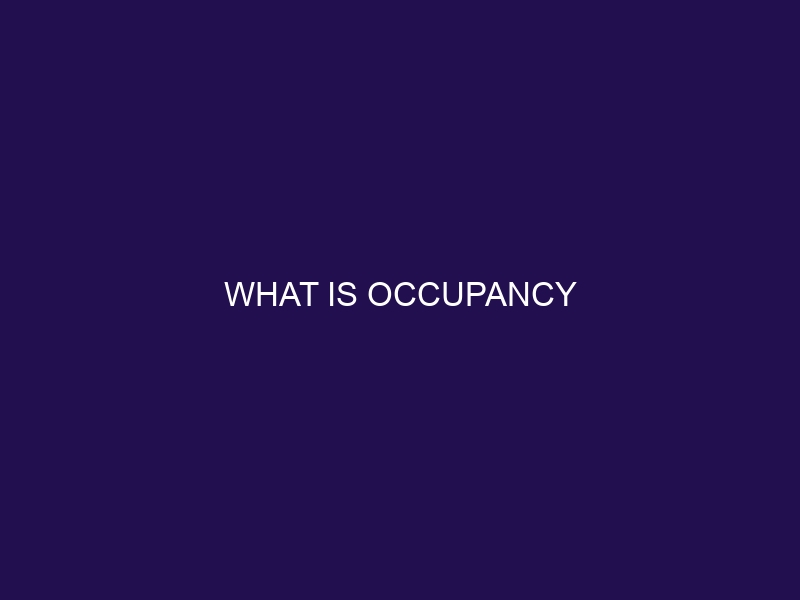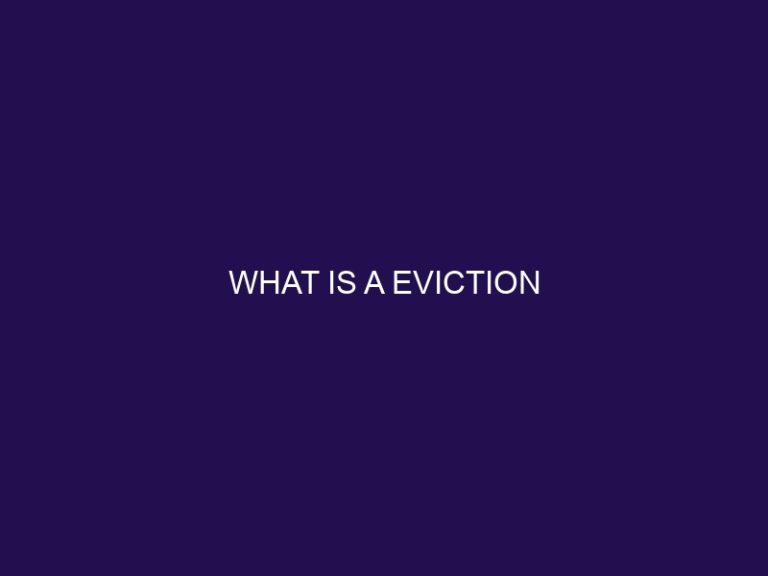What is Occupancy
Occupancy refers to the utilization or occupancy of a space or property by individuals or entities. It is a crucial concept in real estate and property management that determines the degree to which a property is being utilized and generates income. Understanding the definition and types of occupancy is essential for property owners and investors.
There are four main types of occupancy:
1. Residential Occupancy: This refers to properties used for residential purposes, such as houses, apartments, and condominiums.
2. Commercial Occupancy: Commercial occupancy involves properties used for business purposes, including offices, retail stores, and restaurants.
3. Industrial Occupancy: Industrial occupancy includes properties used for manufacturing, warehousing, and industrial operations.
4. Institutional Occupancy: Institutional occupancy involves properties used by institutions such as schools, hospitals, and government buildings.
Several factors affect occupancy levels, including location, market demand, building quality, and economic conditions. These factors play a significant role in determining the success and profitability of a property.
Occupancy is crucial for multiple reasons:
1. Revenue Generation: Occupied properties generate rental income or profits from business operations, contributing to financial stability and growth.
2. Job Creation: Occupied properties create job opportunities, both directly and indirectly, by supporting businesses and industries.
3. Community Development: Occupied properties contribute to the development and vitality of communities, providing services, and supporting local economies.
Occupancy rates and metrics are used to measure and evaluate the performance of properties:
1. Occupancy Rate Calculation: This measures the percentage of available space that is currently occupied or leased.
2. RevPAR (Revenue Per Available Room): RevPAR calculates the average revenue generated per available room in the hospitality industry, reflecting the property’s occupancy and pricing strategy.
3. ADR (Average Daily Rate): ADR represents the average rate at which rooms are rented per day, providing insights into the property’s pricing and revenue management strategies.
To effectively manage occupancy, strategies such as marketing and advertising, customer service and satisfaction, and pricing and revenue management are employed. These strategies ensure maximum occupancy levels and optimize profitability for property owners and investors.
Definition of Occupancy
Occupancy is the legal or contractual possession and use of a property. The Definition of Occupancy refers to the act of occupying or taking possession of a space for various purposes, such as living, working, or conducting business activities. In real estate, the Definition of Occupancy is a crucial concept that defines the rights and responsibilities of both tenants and landlords. The definition of occupancy varies depending on the context, but it generally involves the physical presence and utilization of a property. Understanding the Definition of Occupancy is essential for ensuring compliance with legal regulations and establishing clear agreements between parties involved in property transactions.
Types of Occupancy
When it comes to occupancy, there’s a whole range of types to consider. From residential and commercial to industrial and institutional, each category brings its own set of characteristics. But what drives the choice of occupancy? Factors like location, market demand, building quality, and economic conditions play a pivotal role. So, fasten your seatbelts as we dive into the diverse world of occupancy and explore how different factors shape the choices we make.
Residential Occupancy
Residential occupancy refers to the utilization of a property for residential purposes. It encompasses dwellings, flats, condos, and other types of housing units. Factors impacting residential occupancy include location, market demand, building quality, and economic circumstances. Desirable locations with high-quality residential properties tend to experience greater occupancy rates. Residential occupancy is crucial as it contributes to revenue generation, job creation in the construction and property management industries, and the development of communities. Proper understanding of occupancy rates and metrics such as occupancy rate calculation, Revenue Per Available Room (RevPAR), and Average Daily Rate (ADR) is essential for effective occupancy management. Residential occupancy plays a vital role in fulfilling the housing requirements of individuals and families.
The concept of residential occupancy can be traced back thousands of years when early human settlements consisted of improvised shelters. As civilizations advanced, permanent housing structures were erected to accommodate the growing populations. In ancient civilizations like Mesopotamia and Egypt, residential occupancy played a fundamental role in community life, with housing design and construction techniques evolving to meet the evolving societal needs. Today, residential occupancy remains an integral part of human civilization, providing individuals and families with a place they can call home and fostering thriving communities.
Commercial Occupancy
Commercial occupancy refers to the use of a property for business purposes. When considering commercial occupancy, several factors should be taken into account:
- Location: The location of the property plays a crucial role in determining its suitability for commercial occupancy. Factors such as proximity to customers, accessibility, and visibility are important.
- Market Demand: Understanding the demand for commercial occupancy in the area is essential. Analyzing market trends and competition can help determine the potential success of a commercial venture.
- Building Quality: The quality and condition of the building are important considerations. A well-maintained and modern infrastructure can attract tenants and customers.
- Economic Conditions: The economic climate, including factors such as local GDP growth and employment rates, can impact the viability of commercial occupancy.
By carefully considering these factors, businesses can make informed decisions when it comes to commercial occupancy, optimizing their chances of success.
Industrial Occupancy
Industrial occupancy refers to the use of a building or space for industrial purposes such as manufacturing, warehousing, or logistics. When considering industrial occupancy, it is crucial to take into account certain factors to ensure a successful operation.
- Space requirements: Evaluate the size and layout of the facility to determine if it can accommodate the specific needs of the industrial operation.
- Infrastructure: Consider the availability of utilities like electricity, water, and sewer systems, as well as transportation access for the efficient movement of goods.
- Zoning regulations: Check if the property is zoned for industrial use and comply with any environmental, safety, or health regulations unique to industrial occupancy.
- Security: Assess the security measures in place to protect against theft, vandalism, and unauthorized access to valuable equipment and inventory.
- Flexibility: Look for a space that allows for future expansion or customization as the business grows or changes over time.
Fact: Industrial occupancy plays a crucial role in economic growth, providing job opportunities, contributing to innovation, and supporting supply chain operations.
Institutional Occupancy
- Institutional occupancy refers to buildings or spaces that are used for institutional purposes, such as schools, hospitals, government buildings, or religious institutions. When considering institutional occupancy, there are several factors to take into account:
- Regulations: Institutional buildings must adhere to specific regulations and codes to ensure safety and accessibility for all occupants.
- Specialized Facilities: These spaces often require specialized facilities, such as classrooms, laboratories, medical equipment, or worship areas.
- Long-Term Operations: Institutional buildings are typically designed for long-term use, with considerations for durability, maintenance, and adaptability to evolving needs.
- Community Impact: Institutional occupancy plays a significant role in community development, providing essential services, education, healthcare, or public administration.
Fact: Institutional occupancy often requires collaboration and coordination among multiple stakeholders, including government entities, professionals, and community members.
Location
Location is a crucial factor when considering occupancy rates for various types of properties. The location of a property directly impacts its demand and competitiveness in the market. A prime location can attract more customers and generate higher revenue. For example, a hotel located near popular tourist attractions or business districts is more likely to have higher occupancy rates compared to one in a less favorable location. It is important for property owners and managers to carefully select locations that align with their target market and cater to the specific needs of their customers. Keeping an eye on market trends and developments in the surrounding area can help identify opportunities for growth and improvement.
Market Demand
Market demand is a crucial factor that significantly impacts occupancy in different types of properties. To gain an understanding of market demand, one must take into account various elements such as population growth, economic conditions, and consumer preferences. In the realm of residential occupancy, market demand plays a crucial role in determining the need for housing as well as rental or sale prices. On the other hand, for commercial occupancy, the demand for office spaces, retail stores, and restaurants is heavily reliant on local business activities and consumer spending. Furthermore, industrial occupancy primarily revolves around the demand for warehouse and manufacturing spaces. As for institutional occupancy, which includes schools and hospitals, it is influenced by population growth and government policies. By comprehending market demand, property owners and developers are able to align their offerings with the needs of consumers, thus maximizing occupancy rates.
As an example, the demand for residential occupancy in City X has experienced a steady increase over the past five years, thanks to the burgeoning population and a thriving job market. Consequently, real estate developers have devoted their attention to constructing new apartment buildings and homes to meet this escalating demand. This, in turn, has led to an impressive occupancy rate within the residential sector, contributing to a steady stream of revenue for property owners and fostering overall economic growth in City X.
Building Quality
Building quality is a fundamental aspect when it comes to determining occupancy rates. The construction and maintenance of a building play a crucial role in attracting tenants and ensuring their satisfaction. Here are some key factors to consider when it comes to building quality:
| 1. Structural integrity: | The foundation of a building should be solid, and there should be no significant defects or issues. This includes having proper electrical wiring and maintaining the plumbing systems effectively. |
|---|---|
| 2. Safety measures: | Adequate fire safety features such as sprinkler systems, fire alarms, and emergency exits are vital. Buildings with reliable safety measures are more likely to comply with regulations and attract tenants. |
| 3. Maintenance and cleanliness: | Regular maintenance and cleanliness of common areas and facilities contribute to a positive experience for tenants. Well-maintained buildings enhance the overall appeal and value of the property. |
| 4. Energy efficiency: | Buildings that have energy-efficient systems, including proper insulation and energy-saving appliances, can lead to cost savings for tenants. In today’s market, there is an increasing demand for green buildings that prioritize sustainability. |
| 5. Aesthetics: | The design and aesthetic appeal of a building can significantly influence occupancy rates. Modern and visually pleasing buildings often attract more tenants and can command higher rental rates. |
By prioritizing building quality, property owners and managers can create an appealing and desirable environment that will attract potential tenants. This, in turn, can result in higher occupancy rates and overall success in the real estate market.
Economic Conditions
Economic conditions are critical in determining the occupancy levels of different types of properties. In a robust economy, there is typically a surge in demand for residential, commercial, industrial, and institutional spaces. Factors like low unemployment rates and strong consumer confidence contribute to higher occupancy rates, resulting in increased revenue and job opportunities. Conversely, during an economic downturn, there may be a decline in occupancy rates due to reduced demand and tighter budgets. It is crucial for property owners and managers to closely monitor economic conditions and adjust their strategies accordingly to maintain optimal occupancy levels and maximize profitability. Ultimately, the success and stability of occupancy in various sectors heavily depend on economic conditions.
Importance of Occupancy
Discover the incredible significance of occupancy and delve into its remarkable impact. Uncover how occupancy plays a key role in revenue generation, job creation, and community development. Get ready to explore the fascinating facts and figures that shed light on the importance of occupancy in various industries. Let’s embark on this enlightening journey to understand the true value and potential of occupancy in our modern world.
Revenue Generation
To generate revenue, occupancy plays a crucial role in various industries. Here are some ways it contributes to revenue generation:
- Higher Occupancy Rates: Revenue generation is directly influenced by increasing occupancy rates, as it leads to more room bookings, rentals, or utilization of space.
- Additional Services: Occupied spaces provide opportunities for upselling and cross-selling additional services, such as room service, spa treatments, or conference facilities, contributing to revenue generation.
- Repeat Business: Continuous revenue generation is fueled by satisfied customers who stay longer or return for future visits.
- Ancillary Income: Occupancy can boost revenue through the sale of products, dining options, or partnerships within the facility, further contributing to revenue generation.
- Brand Reputation: A high occupancy rate enhances brand perception, attracting more customers and increasing revenue opportunities for the business.
Historically, the hospitality industry saw a significant boost in revenue generation with the rise of modern tourism in the early 20th century. The advent of luxury hotels and efficient transportation systems led to increased occupancy rates and greater revenue flow.
Job Creation
Job creation is one of the key benefits of occupancy. When buildings are occupied, especially in commercial and industrial sectors, new job opportunities are created. This helps boost the local economy by providing employment opportunities to individuals. Job creation plays a significant role in community development, as it leads to increased income, improved living standards, and a thriving business environment. For example, in a small town, the establishment of a new factory can create hundreds of jobs, transforming the local economy. Occupancy contributes to job growth and fosters economic development in a region.
True story: The opening of a new shopping mall in a city resulted in the creation of over 500 new jobs. This not only provided employment opportunities for local residents but also attracted people from surrounding areas. The mall became a hub of economic activity, with various businesses thriving and contributing to the overall growth and development of the community. The job creation sparked by the mall had a ripple effect, boosting consumer spending and driving further economic expansion in the region.
Community Development
Community development plays a pivotal role in the occupancy of a specific area, as it greatly contributes to the overall growth and well-being of the community. This approach entails a range of initiatives and efforts that endeavor to enhance the quality of life for residents. These initiatives include the development of essential infrastructure, ensuring access to healthcare and education, and promoting cultural activities. Hence, the significance of these community development endeavors cannot be overstated, as they are essential in attracting both businesses and residents to the area. As a result, the occupancy rates increase, thereby driving economic growth. What’s more, community development fosters a sense of belonging and pride among residents, ultimately creating a vibrant and sustainable community.
Occupancy Rates and Metrics
Occupancy rates and metrics are essential tools for understanding the utilization and profitability of a space. In this section, we will dive into the fascinating realm of occupancy rates, exploring how they are calculated and the key metrics associated with them. Get ready to uncover the secrets behind RevPAR (Revenue per Available Room) and ADR (Average Daily Rate), as we delve into the fascinating world of occupancy analytics and their impact on the hospitality industry.
Occupancy Rate Calculation
To calculate the occupancy rate, you can utilize the following steps:
- Retrieve the total number of occupied units within a specific time frame.
- Determine the total number of available units during the same period.
- Divide the number of occupied units by the number of available units.
- Multiply the resulting value by 100 to obtain the occupancy rate percentage.
For instance, let’s say there were 80 occupied units out of a total of 100 available units. The occupancy rate would then be 80% (80/100 x 100).
An illustrative real-life scenario underscoring the significance of occupancy rate calculation involves a hotel situated in a sought-after tourist destination. By faithfully monitoring their occupancy rate, the hotel managed to pinpoint periods characterized by high demand and subsequently adjust their pricing strategy accordingly. This enabled them to optimize their revenue and ensure optimal utilization of their resources.
RevPAR
Revenue Per Available Room is a key metric used in the hospitality industry to assess the financial performance of a hotel or lodging establishment. It measures the average revenue generated per available room during a specific period. Calculating RevPAR helps in evaluating the effectiveness of hotel operations and pricing strategies.
A RevPAR table might include columns such as:
| Occupancy Rate | Average Daily Rate (ADR) | Revenue | RevPAR |
|---|---|---|---|
| The percentage of available rooms occupied during a certain period. | The average price at which rooms are sold during a specific time frame. | The total revenue generated from room sales during the given period. | The revenue earned per available room, calculated by multiplying the occupancy rate by the average daily rate. |
RevPAR provides valuable insights into a hotel’s financial performance and allows for comparison across different properties and time periods. It helps hoteliers make informed decisions about pricing, marketing strategies, and overall revenue management.
ADR
(Average Daily Rate) is a key metric in the hospitality industry that helps measure the average rate at which each room is sold in a hotel. It is calculated by dividing the total room revenue by the number of occupied rooms. A higher ADR indicates that guests are willing to pay more for the hotel’s services. Hotels can increase their ADR by offering amenities that guests value, such as quality dining options or exclusive spa services. ADR is an essential factor in revenue generation and profit maximization for hotels, as it directly contributes to the overall financial performance.
Occupancy Management Strategies
Occupancy management strategies are crucial for businesses to thrive in today’s competitive landscape. In this section, we will uncover the secrets to success by exploring different aspects such as marketing and advertising, customer service and satisfaction, as well as pricing and revenue management. Get ready to discover innovative techniques, backed by real-world examples and insightful data, that will help you maximize your occupancy rates and stay ahead of the curve. Let’s dive in and unlock the power of effective occupancy management!
Marketing and Advertising
To effectively manage occupancy rates, implementing marketing and advertising techniques is crucial. Here are some key strategies to consider:
Implementing these marketing and advertising strategies can help maximize occupancy rates and drive revenue for your property.
Customer Service and Satisfaction
Customer service and satisfaction play a vital role in enhancing occupancy rates and ensuring the success of any business. Here are some key factors to consider:
- Responsive Communication: Promptly addressing customer inquiries and concerns demonstrates a commitment to excellent service.
- Personalized Experience: Tailoring services and interactions to meet individual customer needs and preferences fosters a positive and memorable experience.
- Attentive Staff: Well-trained and friendly staff who actively listen and anticipate customer needs create a comfortable and welcoming environment.
- Prompt Issue Resolution: Swiftly resolving customer issues or complaints shows dedication to resolving problems effectively and maintaining satisfaction.
- Consistent Quality: Delivering consistent, high-quality services and products establishes trust and builds long-term customer relationships.
Keywords to incorporate: Customer Service and Satisfaction
Customer service and satisfaction are crucial aspects that significantly impact occupancy rates and ensure the triumph of any business. Here are some key factors to consider:
- Responsive Communication: Promptly addressing customer inquiries and concerns demonstrates a strong commitment to excellent customer service, ensuring customer satisfaction.
- Personalized Experience: Tailoring services and interactions to cater to individual customer needs and preferences fosters a positive and memorable customer experience, enhancing overall customer satisfaction.
- Attentive Staff: Well-trained and amiable staff, who actively listen and anticipate customer requirements, create a comfortable and welcoming environment, leading to enhanced customer satisfaction.
- Prompt Issue Resolution: Swiftly resolving customer issues or complaints exhibits utmost dedication to effectively addressing problems and maintaining customer satisfaction.
- Consistent Quality: Delivering consistent, high-quality services and products establishes trust, further strengthening long-term customer relationships based on satisfaction.
Pricing and Revenue Management
Pricing and revenue management are vital elements of managing occupancy. The success of a property greatly depends on implementing effective strategies in this area. Below is an example table that highlights key components of pricing and revenue management:
| Component | Description |
|---|---|
| Market Analysis | Analyzing market trends and competition to set prices |
| Dynamic Pricing | Adjusting prices based on demand and occupancy levels |
| Revenue Forecasting | Predicting future revenue based on historical data |
| Promotions and Packages | Creating attractive offers to incentivize bookings |
| Online Distribution | Maximizing visibility and bookings through online channels |
| Yield Management | Optimizing revenue by selling the right product to the right customer at the right time |
| Direct Booking Strategies | Encouraging direct bookings through special perks or discounts |
| Upselling and Cross-Selling | Offering additional services or upgrades to increase revenue |
By implementing effective pricing and revenue management strategies, property owners can maximize occupancy rates and overall profitability.
Frequently Asked Questions
What is occupancy?
Occupancy refers to the fact or condition of holding, possessing, or residing in or on something. It can also mean the act or fact of taking or having possession to acquire ownership.
How is occupancy rate calculated?
Occupancy rate is calculated by dividing the rented or used space by the total available space. It is commonly used in sectors such as senior housing, hospitals, hotels, and rental units.
Why are occupancy rates important for real estate investors?
Occupancy rates are important for real estate investors as they indicate anticipated cash flows. A low occupancy rate means that tenants are leasing a small percentage of the available space, which may require the investor to find additional tenants and face maintenance costs and property taxes. Properties with low occupancy rates often sell for less than those with high occupancy rates.
What factors can contribute to a low occupancy rate?
Low occupancy rates can be indicative of issues such as location, amenities, or poor management. Investors may also consider the occupancy rates of nearby hotels and facilities when evaluating a property, as these rates can provide insights into the financial health of the area and the potential customer base for businesses like restaurants.
How are occupancy rates used in hospitals and nursing homes?
In hospitals and nursing homes, occupancy rates are used to manage overcrowding and assess growth and demand. Specific department occupancy rates are tracked to analyze trends, and aggregate numbers are used by governments and organizations to plan public health initiatives.
What is the impact of occupancy rates on insurance premiums?
Occupancy rates can impact insurance premiums for various properties. Insurance providers assess the level of risk associated with different occupancy types and adjust premiums accordingly. Higher occupancy rates may result in higher premiums, while lower occupancy rates may lead to reduced premiums.







